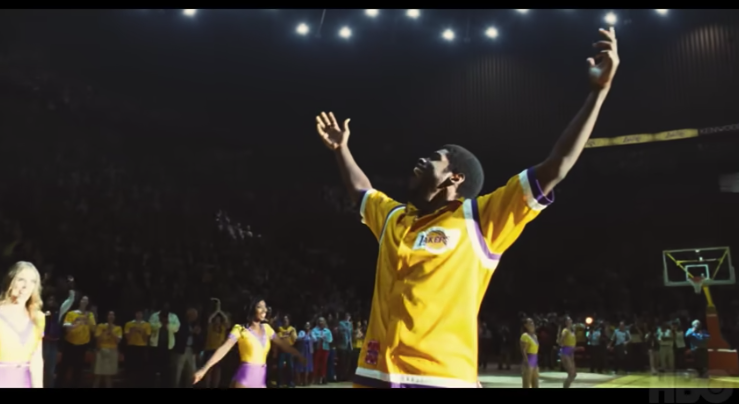If you love HBO’s Winning Time: the Rise of the Lakers Dynasty, there’s great news. Season Two of the basketball drama about the Magic-Johnson-led Los Angeles Lakers of the 1980s debuts on Sunday night. We thought it would be an ideal time to connect with the show’s basketball producer Idan Ravin. Ravin is best known in NBA circles as a trainer and has worked with superstars like Steph Curry, Kobe Bryant, and Kevin Durant. On ‘Winning Time,’ he’s responsible for the on-court choreography.
We spoke to Ravin about the challenges of bringing iconic players and iconic moments to life.
Note: This interview has been edited and condensed for length and clarity.
Awful Announcing: How was Season Two different from Season One?
Idan Ravin: “You have more experience under your belt. Things can become more precise, and more sophisticated. There’s a certain rhythm and you kind of know what you’re playing with. You know where to tweak, refine, and when to put a little more on the accelerator. It was great. I think we pushed it more this year because we knew more.”
How did you first become involved in Winning Time?
“I got a call three years ago from one of the producers on the show asking if I could help turn one of the actors into Magic Johnson. I remember laughing. There are 400 guys in the NBA who can’t be Magic Johnson. This is a top 3 player in history. They said ‘Hey, we’re doing this show. We’re going to shoot a pilot. Can you help?’ I said ‘Sure.’ They said you have about a week. I laughed again. A week? This could take a lifetime.”
What was it like working with Quincy Isaiah to transform him into Magic?
“I flew out to L.A. to meet Quincy. Quincy’s background was as a former lineman in college football. There’s a different level of athleticism when you play football vs. basketball. As a lineman, you’re confined to a certain space, and there’s a certain physicality. We had to improve upon the athleticism that’s related to basketball. From there, we had to build a strong basketball player. And from there, we had to build a silhouette. So, it was three phases to turn Quincy into the Magic that on camera feels like Magic. Cinematic, authentic, and charismatic. I think Quincy did a great job with that.”
How did that job evolve into becoming the basketball producer?
“What (started) as one task became many tasks. Adam (McKay) was very happy with Quincy’s development. That became working with our Kareem Abdul-Jabbar character, our Norm Nixon character, our Michael Cooper character, our Larry Bird character, our Jamaal Wilkes, and our Dr. J character.
“Every iconic basketball figure you see on the show, they all had to master that silhouette. That was intricate. Some (actors) had more of a basketball background than others. But sometimes when you have more of a basketball background, it’s a little more challenging. You have to operate against your intuition. Solomon (Hughes) was a very successful college basketball player. But playing Kareem is a bit counterintuitive. You have to learn how to play slow and powerful. These days basketball is about playing fast so you can score. But (Hughes) is so smart and thoughtful that he picked it up.”
What were some of the other challenges?
“Just because you learn the choreography, that doesn’t mean you execute it perfectly on camera. So, it’s connecting with the director and the talent and making sure that everything works. There are improvisational elements that can happen when you’re shooting. You might want to tweak something. So, you have to be able to adjust on the fly so that it’s camera-ready and it really sells. There is the element of interpreting the basketball elements of the script, making sure that it’s cinematic. authentic and that there are no holes in the narrative.”
Who was the hardest player to replicate?
“Jamaal Wilkes’ jumper was the most challenging. There are so many idiosyncrasies to it. That jump shot was hard to replicate. The Dr. J stuff was very tough. Our Larry Bird was really tough, but Sean Patrick Small is such a great student and so receptive to all types of notes that Sean had mastered it by Season Two. He just kills it. There’s so much to Larry Bird. Not just the jumper but how his pelvis rotates, how his feet rotate, how he turns, his mannerisms, how he dribbles, how he runs, how he does it with a straight face but kind of smirks.”
https://www.youtube.com/watch?v=z76liPf7o-4
How much old game footage did you watch?
“The great thing is I love basketball, so that was never a chore. I watched for thousands of hours but I was also very familiar, even before this. The (challenge) was having to stay true to the script. That’s the bible. Because you want to deliver on the intent of the writer. What might have happened during the game does not always have to fit within the script. You honor the essence of that moment. Then you have the creative liberty to depict it.”
How much pressure did you feel to capture these iconic moments?
“For years, I’ve been in the gym with Steph Curry, James Harden, Camelo Anthony, Dwyane Wade, Kevin Durant, Kobe Bryant, Chris Paul, and all of these Hall of Famers. It’s similar pressure. Someone is trusting you with something important in their life. I treat it with reverence, and I deliver. It’s a big responsibility, and I believe I’m there for a reason.”
What’s your favorite basketball movie?
“Hoosiers has always been very touching to me because I related to Jimmy Chitwood. That’s someone who loved the game and developed in solitude. That’s sort of how I learned the game.”
Winning Time debuts Sunday at 9 p.m. ET/PT on HBO. It will also be available on Max.







